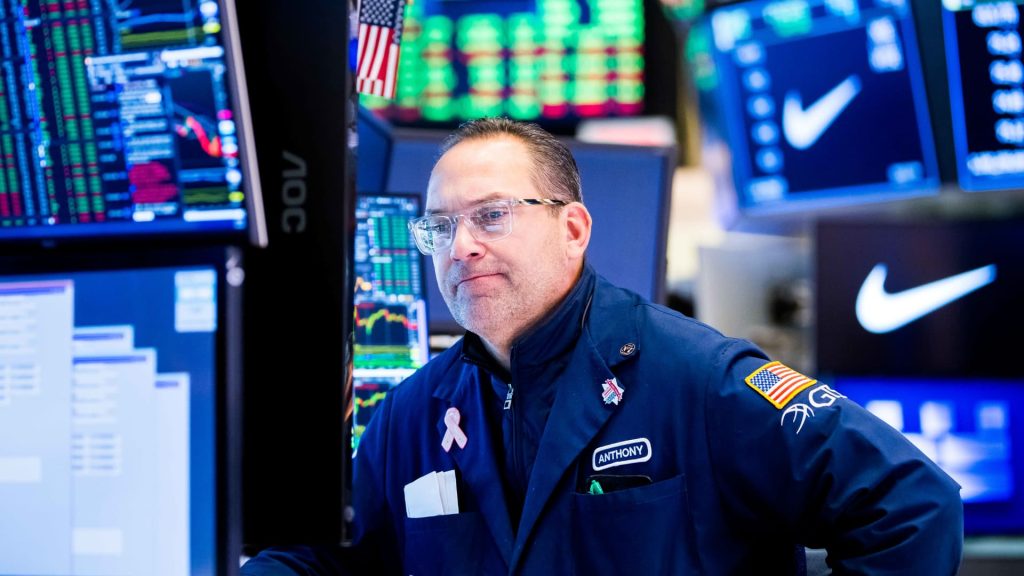Stock futures are little changed as investors brace for big payrolls report: Live updates – CNBC

Credit CardsLoansBankingMortgagesInsuranceCredit MonitoringPersonal FinanceSmall BusinessTaxesHelp for Low Credit ScoresInvestingSELECTAll Credit CardsFind the Credit Card for YouBest Credit CardsBest Rewards Credit CardsBest Travel Credit CardsBest 0% APR Credit CardsBest Balance Transfer Credit CardsBest Cash Back Credit CardsBest Credit Card Welcome BonusesBest Credit Cards to Build CreditSELECTAll LoansFind the Best Personal Loan for YouBest Personal LoansBest Debt Consolidation LoansBest Loans to Refinance Credit Card DebtBest Loans with Fast FundingBest Small Personal LoansBest Large Personal LoansBest Personal Loans to Apply OnlineBest Student Loan RefinanceSELECTAll BankingFind the Savings Account for YouBest High Yield Savings AccountsBest Big Bank Savings AccountsBest Big Bank Checking AccountsBest No Fee Checking AccountsNo Overdraft Fee Checking AccountsBest Checking Account BonusesBest Money Market AccountsBest CDsBest Credit UnionsSELECTAll MortgagesBest MortgagesBest Mortgages for Small Down PaymentBest Mortgages for No Down PaymentBest Mortgages with No Origination FeeBest Mortgages for Average Credit ScoreAdjustable Rate MortgagesAffording a MortgageSELECTAll InsuranceBest Life InsuranceBest Homeowners InsuranceBest Renters InsuranceBest Car InsuranceTravel InsuranceSELECTAll Credit MonitoringBest Credit Monitoring ServicesBest Identity Theft ProtectionHow to Boost Your Credit ScoreCredit Repair ServicesSELECTAll Personal FinanceBest Budgeting AppsBest Expense Tracker AppsBest Money Transfer AppsBest Resale Apps and SitesBuy Now Pay Later (BNPL) AppsBest Debt ReliefSELECTAll Small BusinessBest Small Business Savings AccountsBest Small Business Checking AccountsBest Credit Cards for Small BusinessBest Small Business LoansBest Tax Software for Small BusinessSELECTAll TaxesFiling For FreeBest Tax SoftwareBest Tax Software for Small BusinessesTax RefundsTax BracketsTax TipsTax By StateTax Payment PlansSELECTAll Help for Low Credit ScoresBest Credit Cards for Bad CreditBest Personal Loans for Bad CreditBest Debt Consolidation Loans for Bad CreditPersonal Loans if You Don’t Have CreditBest Credit Cards for Building CreditPersonal Loans for 580 Credit Score or LowerPersonal Loans for 670 Credit Score or LowerBest Mortgages for Bad CreditBest Hardship LoansHow to Boost Your Credit ScoreSELECTAll InvestingBest IRA AccountsBest Roth IRA AccountsBest Investing AppsBest Free Stock Trading PlatformsBest Robo-AdvisorsIndex FundsMutual FundsETFsBondsStocks slid on Friday as a mix of news related to tariffs and inflation worried traders to close out the week.Major benchmarks took a leg lower during the session after President Donald Trump said he was planning reciprocal tariffs on trading partners. This could mean raising tariff levels across the board to equal rates charged to the U.S.The Dow Jones Industrial Average fell 444.23 points, or 0.99%, to close at 44,303.40. The S&P 500 declined 0.95% to 6,025.99, and the Nasdaq Composite slid 1.36% to end at 19,523.40. Friday’s losses left the major averages in negative territory on the week.”I’ll be announcing that next week reciprocal trade, so that we’re treated evenly with other countries,” said Trump during a meeting with the visiting Japanese Prime Minister Shigeru Ishiba. “We’ll have a news conference, and we’ll lay it out pretty simple.”The stock market was already on edge before the Trump comments as some earlier consumer sentiment and jobs data pointed to a pickup in inflation and spiked the 10-year Treasury yield above 4.5% at its session high.Consumer sentiment fell in February to 67.8, according to a preliminary reading of the University of Michigan’s consumer sentiment index. Economists polled by Dow Jones had expected 71.3.But perhaps more concerning was that the report’s respondents anticipate the one-year inflation rate to hit 4.3%, marking a rise of one percentage point from the previous month and its highest level since November 2023.Also released on Friday, January’s jobs report showed the unemployment rate fell to 4% from 4.1% and that average hourly earnings last month were higher than expected.Amazon lost 4% after guidance from the e-commerce giant disappointed investors. The company called for revenue growth of 5% to 9% in the first quarter, its weakest growth on record. The outlook overshadowed top- and bottom-line beats in the fourth quarter. Alphabet continued to fall following somewhat-disappointing results earlier in the week.”We’ve just had some disappointments in the traditionally non-disappointing tech or ‘Magnificent Seven’ areas, and so I think we’re seeing some rotation away from those groups,” said Sam Stovall, chief investment strategist at CFRA Research. “I don’t think that we’re heading for a bear market but rather just probably heading for some volatility and short-term disappointment.”It has been a volatile week. Stocks fell on Monday after President Donald Trump over the weekend announced 10% tariffs on China. He also proposed, then later paused, 25% levies on Canada and Mexico. The S&P 500 then gained for three straight days on the tariff reprieve before falling again on Friday.Correction: An earlier version misstated the session high for the 10-year Treasury yield.Stocks closed out the first trading week of February in negative territory.The Dow Jones Industrial Average closed 444.23 points, or 0.99%, lower to finish at 44,303.40. The S&P 500 dropped 0.95% to finish at 6,025.99, and the Nasdaq Composite declined 1.36% to settle at 19,523.40.— Sean ConlonShares of XPO could see more upside from here, according to Bank of America.The bank named the freight company a top pick and reiterated its buy rating on the name. Its updated price target implies 15.7% upside from Thursday’s close.”XPO continues to demonstrate solid momentum in generating Less-than-Truckload (LTL) service, yield and productivity gains as it works to narrow the margin gap between it and best-in-class peer Old Dominion,” analyst Ken Hoexter wrote in a note to clients.”We are bullish given its improving margin, returns, and cash flow before a freight rebound,” the analyst also said.The stock has substantially outperformed the broader market this year, rising around 12% year to date. It is also on pace for a positive week, seeing week-to-date gains of about 10%.— Sean ConlonAccording to the Super Bowl Indicator, allegedly created by the late New York Times sportswriter Leonard Koppett and popularized by the late Dean Witter Reynolds market strategist Bob Stovall, stocks should do better this year if the Philadelphia Eagles, an original NFL team, beat the Kansas City Chiefs, an original AFL squad, in this Sunday’s game in New Orleans.But not so fast, says Ryan Detrick, a technical analyst at Carson Group, who wrote on social media this week that “When Philadelphia Wins a Super Bowl or World Series, Bad Things Happen.” Each of the five years between 1905 and 1930 when the old Philadelphia Athletics won the World Series were marked either by a panic, recession, war, crash or a Great Depression. The two Philadelphia Phillies World Series victories were marked by a double dip recession in 1980 and the Global Financial Crisis in 2008. And when the Eagles won the Super Bowl in 2018, it turned into the worst year for stocks since 2008.For those eight reasons, Detrick claims, “Why America Wants the Chiefs to Win,” although he offers a disclaimer that, “we do not suggest ever investing based on who wins the World Series or the Super Bowl, but it sure is interesting.”For his part, Sam Stovall, chief investment strategist at CFRA and Wall Street’s official keeper of the Super Bowl Indicator — and son of the late Bob Stovall — simply points out that in years when an old NFL or an NFC team wins the Super Bowl, the Dow Jones Industrial Average for whatever reason, rises 82% of the time for an average of 11.4%, while in years that an AFC wins the markets gains only 47% of the time for just a 1.8% advance.Although Stovall, too, notes that “past performance is no guarantee of future results.”— Scott SchnipperMore ETFs that combine bitcoin exposure and derivatives hit the market this week, as the ecosystem of crypto funds looks set to expand rapidly under the Trump administration.After a yearslong wait for basic buy-and-hold bitcoin funds to be approved, fund issuers are working to bring strategies that have found traction with stock investors — such as buffer funds, covered calls and leveraged products — to crypto. Trump’s victory in November, and SEC Acting Chair Mark Uyeda’s crypto task force to change the regulation of the industry, seems to have served as a signal that the next group of funds can get to market quickly.”That era is gone, and all those things that were going to happen slowly are going to happen fast,” said Michael Venuto, chief investment officer and co-founder of ETF white-label platform Tidal Financial.— Jesse PoundNearly two-thirds of the companies in the S&P 500 have reported their quarterly earnings this cycle. Their results indicate a strong earnings picture and outlook.The results show around 15% earnings growth now on a yearly basis, putting this reporting season on pace for the strongest quarter in three years. At the start of the year, Wall Street was expecting just under 10% earnings growth. Earnings have also come in 6.4% above consensus estimates.— Hakyung Kim, Robert HumCheck out the companies making headlines in midday trading:The full list can be found here.— Hakyung KimThirty-five S&P 500 stocks were trading at new 52-week highs on Friday.Among them, 23 notched fresh all-time highs. Here are some of the stocks that reached the milestone:However, 17 stocks, including Nike and Ford, hit new 52-week lows during the session. Nike was trading at lows not seen since March 2020, while Ford was trading at lows not seen since January 2021.— Sean Conlon, Christopher HayesFrontier Airlines shares surged 17%, trading late morning at the highest level since July 2023, after its upbeat outlook and swing to a profit for the last three months of 2024.The ultralow-cost airline is tweaking its business model to offer roomier, first-class seats and other perks as consumers repeatedly show a willingness to pay higher fares for more room on board.Frontier posted a $54 million profit in the last three months of the year from a $37 million loss a year earlier. The carrier is also trying to merge with bankrupt rival Spirit Airlines, but the two sides have not yet reached a deal.— Leslie JosephsDuring Friday’s market sell-off, just one out of the 11 GICS sectors was trading positive: energy stocks.But on a weekly basis, 6 out of the 11 sectors were still on pace for a gain. Consumer staples, up 1.7% on the week, led the advance, followed by energy stocks, up 1.3%, and the information technology cohort, up 1.1%.The health-care sector was trading around flat on the week, but was last marginally lower.Consumer discretionary stocks were the worst-performing sector and on pace for a 3% weekly plunge, followed by the communication services sector, down 2%.— Lisa Kailai HanAll but one of the 11 S&P 500 sectors were falling in morning trading.The index’s move lower was led by consumer discretionary and communication services, which fell 1.9% and 1.1%, respectively.Those two sectors were then followed by information technology, materials and real estate. Information technology and materials slid 0.8%, while real estate fell 0.6%.Meanwhile, energy was the only gainer, as that sector rose about 0.3%.— Sean ConlonStocks opened Friday’s trading session little changed on the heels of January’s jobs reading.The S&P 500, along with the Nasdaq Composite, traded around the flatline. The Dow Jones Industrial Average gained 24 points, or 0.06%.— Sean ConlonThe U.S. economy added just 143,000 jobs in January, but the unemployment rate fell to 4%, according to data from the Bureau of Labor Statistics.Jobs growth in January was down significantly from an upwardly revised 307,000 in December and missed Dow Jones consensus expectations of 169,000 for the month.The report made significant revisions to 2024 totals. The revisions, which the BLS does each year, reduced the jobs count by 589,000. A preliminary adjustment back in August 2024 had indicated 818,000 fewer jobs.— Jeff Cox, Spencer KimballHSBC analyst Meredith Prichard Jensen is optimistic on Expedia stock following the company’s fourth-quarter results.The firm upgraded the online booking stock to buy in a Thursday note, and raised its target price to $215 per share from $195. HSBC’s forecast calls for about 25% upside from Thursday’s $172.57 close. “In our view, 4Q24 provided sequential confirmation that the Vrbo turnaround is on track with system room night growth +11.6% [year-over-year] driving lodging gross bookings +12.5% [year-over-year], which in our view, broadly reflect pricing trends for the broader market,” the analyst said. — Brian EvansIn a Friday note to clients, Citi analyst Paul Lejuez upgraded shares of Deckers Outdoor to a buy rating from neutral.Shares of the footwear designer and distributor have surged 24% over the past 12 months. Lejuez’s $215 price target is approximately 25% above where the stock closed Thursday afternoon.”We believe the 24% sell off in shares post 3Q is unwarranted, and largely driven by fears of slowing Hoka growth, which we view as misunderstood/overblown,” he wrote. “We believe underlying demand remains strong … DECK trades at an F26E P/E multiple of 24x, below other high-growth peers, suggesting a favorable risk/reward,” the analyst added.Lejuez elaborated that he still believes Hoka can achieve 20% growth in fiscal 2026, something the market fears the brand cannot pull off. The analyst added that the Ugg brand’s more consistent growth gives him confidence that 2026 will be “another year of strong performance,” especially when considering the product pipeline ahead.— Lisa Kailai HanWells Fargo analyst Mike Mayo lifted his price target for JPMorgan to $300 from $270, citing the second Trump administration as a catalyst.Shares of JPMorgan have soared 58% over the past 12 months. Mayo’s revised price target now implies potential upside of 8% ahead for the stock.”JPM reflects ‘Goliath is Winning’ given mkt share gains, best-in-class performance, and what we see as the most positive regulatory inflection in 3 decades,” the analyst wrote. “We remind that Treasury Sec. Bessent has stated that a regulatory overhaul ‘will encourage more lending and reinvigorate banks’ — which is important given the lull in loan growth this decade,” the analyst added.Mayo added that other possible positives for the stock include pretax margin on capital markets and greater-than-expected return of loan growth.— Lisa Kailai HanShares of Pinterest soared 20% in Friday’s premarket trading hours following its latest earnings report and an upgrade to an outperform rating at Bernstein.In its last quarter, Pinterest reported adjusted EBITDA of $470.9 million, beating FactSet’s estimate of $445.9 million. Pinterest’s $1.15 billion revenue was also slightly above the expected $1.14 billion.In a note to clients, Bernstein analyst Mark Shmulik accompanied his upgrade to outperform from market perform by lifting his price target to $47 from $34. This implies a potential upside of approximately 40% ahead for the social media stock.”Pinterest grew adj. EBITDA margins by 5ppts Y/Y to 28% in 2024 with management re-iterating room for further margin expansion despite AI investments,” Shmulik wrote. “It’s possible that this quarter was a one-off, though we see enough evidence in execution to believe the pace of progress is sustainable,” the analyst added.Shares of Pinterest have declined 18% over the past 12 months.— Lisa Kailai HanCiti upgraded Hershey to a neutral rating from sell following the chocolate confectionary manufacturer’s latest earnings report.On Thursday, Hershey reported a fourth-quarter adjusted earnings and revenue beat. Citi upgraded the stock in the aftermath but lowered its price target to $154 from $159, now implying upside of just 1%.”We do not see much near-term upside in the stock price — not when the shares trade at >25x this year’s earnings and cocoa remains persistently high. But we think yesterday’s 2025 guidance (of $6.00-6.18) sets a reasonable floor off which the company is likely to grow in 2026, even if cocoa prices do not decline,” wrote analyst Thomas Palmer. “And when considering the assumptions under-pinning the guidance HSY laid out for 2025, we think there are more potential upside drivers (especially incremental pricing, or lower elasticity) than risk items (cocoa is locked in),” the analyst added.Meanwhile, Palmer also pointed out that underlying sales trends have improved, both in terms of pricing and volume.Shares of Hershey have shed 22% over the past 12 months. The stock was last set to open Friday’s trading session 1% higher.— Lisa Kailai HanIndividual investors are the most bearish toward U.S. stocks in 15 months, since November 2023, according to the latest weekly survey from the American Association of Individual Investors. Pessimism on the outlook for stocks over the next six months jumped to 42.9% of respondents from 34.0% last week.The historical bearish average is just 31.0%.Bullishness toward stocks tumbled to 33.3%, down from 41.0% last week, only the lowest in three weeks, since mid-January. The historical average of bullishness is 37.5%. Those who are neutral on stocks accounted for the balance.Investors were asked a special question this week, and the majority, 52.5%, said U.S. stocks are overvalued. Slightly more than a third, 36.9%, said valuations are mixed, with some areas expensive and others cheap. Only 7.1% said stocks are fairly valued and 1.4% said stocks are undervalued.— Scott SchnipperThe recent interplay among stocks, bonds, currencies and crypto assets might best be described as “Cat in The Hat Markets,” according to Peter Atwater of Financial Insyghts.In a note out Wednesday responding to last week’s DeepSeek-induced panic and Monday’s brief, tariff-induced slump in stocks, Atwater also described the current market as “The Cat in The Hat Goes to Washington.””We’ve reached the point where we have Mom and Dad leave for the day before the markets open,” wrote Atwater, an adjunct professor at the College of William & Mary. “Chaos ensues at 9:30, yet before the market closes and moments before they come back, everything is put back in place. If you like to trade intraday volatility, I suppose it is exciting. What troubles me is that having successfully lived through this experience twice (with DeepSeek and now tariffs), the bulls expect the game to continue. They believe Trump is all bark and no bite. BTFD. It may not be this week or even next, but at some point in the not too distant future, the Cat In the Hat is going to leave a mess, not because he wants to, but because that is the consequence,” Atwater wrote.— Scott SchnipperU.S. stock futures slipped Thursday night.Futures tied to the Dow Jones Industrial Average dipped 49 points, or 0.1%. S&P 500 and Nasdaq 100 futures inched down around 0.2% each.— Hakyung KimGot a confidential news tip? We want to hear from you.Sign up for free newsletters and get more CNBC delivered to your inboxGet this delivered to your inbox, and more info about our products and services.© 2025 CNBC LLC. All Rights Reserved. A Division of NBCUniversal
Data is a real-time snapshot *Data is delayed at least 15 minutes.
Global Business and Financial News, Stock Quotes, and Market Data
and Analysis.
Data also provided by
Source: https://www.cnbc.com/2025/02/06/stock-market-today-live-updates.html





